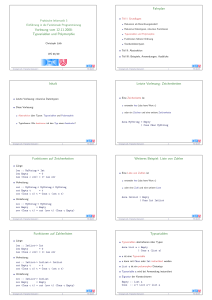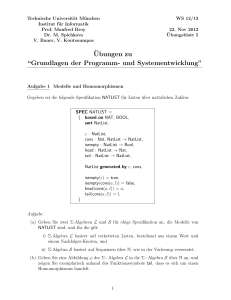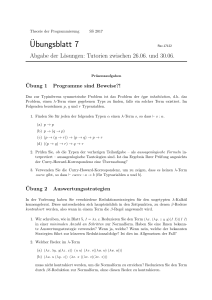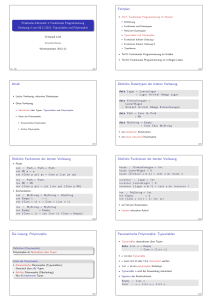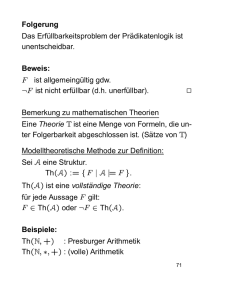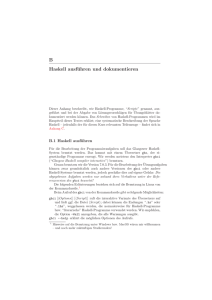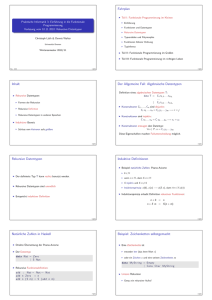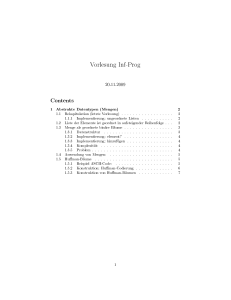Praktische Informatik 3 Einführung in die Funktionale Programmierung
Werbung
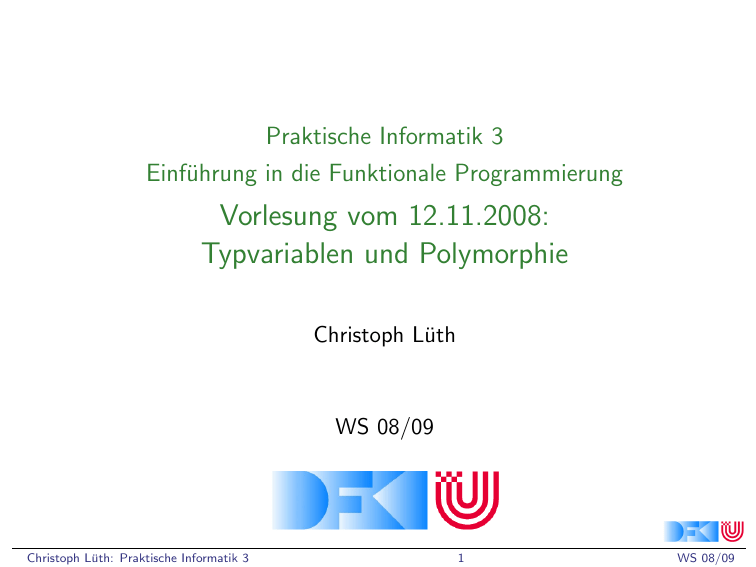
Praktische Informatik 3
Einführung in die Funktionale Programmierung
Vorlesung vom 12.11.2008:
Typvariablen und Polymorphie
Christoph Lüth
WS 08/09
Christoph Lüth: Praktische Informatik 3
1
WS 08/09
Fahrplan
Teil I: Grundlagen
Rekursion als Berechnungsmodell
Rekursive Datentypen, rekursive Funktionen
Typvariablen und Polymorphie
Funktionen höherer Ordnung
Funktionaler Entwurf, Standarddatentypen
Teil II: Abstraktion
Teil III: Beispiele, Anwendungen, Ausblicke
Christoph Lüth: Praktische Informatik 3
1
WS 08/09
Inhalt
Letzte Vorlesung: rekursive Datentypen
Diese Vorlesung:
Abstraktion über Typen: Typvariablen und Polymorphie
Typinferenz: Wie bestimme ich den Typ eines Ausdrucks?
Christoph Lüth: Praktische Informatik 3
2
WS 08/09
Letzte Vorlesung: Zeichenketten
Eine Zeichenkette ist
entweder leer (das leere Wort )
oder ein Zeichen und eine weitere Zeichenkette
data MyString = Empty
| Cons Char MyString
Christoph Lüth: Praktische Informatik 3
3
WS 08/09
Funktionen auf Zeichenketten
Länge:
len :: MyString-> Int
len Empty
= 0
len (Cons c str) = 1+ len str
Verkettung:
cat :: MyString-> MyString-> MyString
cat Empty t
= t
cat (Cons c s) t = Cons c (cat s t)
Umkehrung:
rev :: MyString-> MyString
rev Empty
= Empty
rev (Cons c t) = cat (rev t) (Cons c Empty)
Christoph Lüth: Praktische Informatik 3
4
WS 08/09
Weiteres Beispiel: Liste von Zahlen
Eine Liste von Zahlen ist
entweder leer (das leere Wort )
oder eine Zahl und eine weitere Liste
data IntList = Empty
| Cons Int IntList
Christoph Lüth: Praktische Informatik 3
5
WS 08/09
Funktionen auf Zahlenlisten
Länge:
len :: IntList-> Int
len Empty
= 0
len (Cons c str) = 1+ len str
Verkettung:
cat :: IntList-> IntList-> IntList
cat Empty t
= t
cat (Cons c s) t = Cons c (cat s t)
Umkehrung:
rev :: IntList-> IntList
rev Empty
= Empty
rev (Cons c t) = cat (rev t) (Cons c Empty)
Christoph Lüth: Praktische Informatik 3
6
WS 08/09
Typvariablen
Typvariablen abstrahieren über Typen
data List a = Empty
| Cons a (List a)
a ist eine Typvariable
a kann mit Char oder Int instantiiert werden
List a ist ein polymorpher Datentyp
Typvariable a wird bei Anwendung instantiiert
Signatur der Konstruktoren
Empty :: List a
Cons :: a-> List a-> List a
Christoph Lüth: Praktische Informatik 3
7
WS 08/09
Polymorphe Datentypen
Typkorrekte Terme:
Typ
Empty
List a
Cons 57 Empty
List Int
Cons 7 (Cons 8 Empty)
List Int
Cons ’p’ (Cons ’i’ (Cons ’3’ Empty))
List Char
Cons True Empty
List Bool
Nicht typ-korrekt:
Cons ’a’ (Cons 0 Empty)
Cons True (Cons ’x’ Empty)
wegen Signatur des Konstruktors:
Cons :: a-> List a-> List a
Christoph Lüth: Praktische Informatik 3
8
WS 08/09
Polymorphe Funktionen
Verkettung von MyString:
cat :: MyString-> MyString-> MyString
cat Empty t
= t
cat (Cons c s) t = Cons c (cat s t)
Verkettung von IntList:
cat :: IntList-> IntList-> IntList
cat Empty t
= t
cat (Cons c s) t = Cons c (cat s t)
Gleiche Definition, unterschiedlicher Typ
Zwei Instanzen einer allgemeineren Definition.
Christoph Lüth: Praktische Informatik 3
9
WS 08/09
Polymorphe Funktionen
Polymorphie erlaubt Parametrisierung über Typen:
cat :: List a -> List a -> List a
cat Empty ys
= ys
cat (Cons x xs) ys = Cons x (cat xs ys)
Typvariable a wird bei Anwendung instantiiert:
cat (Cons 3 Empty) (Cons 5 (Cons 57 Empty))
cat (Cons ’p’ (Cons ’i’ Empty)) (Cons ’3’ Empty)
aber nicht
cat (Cons True Empty) (Cons ’a’ (Cons 0 Empty))
Typvariable: vergleichbar mit Funktionsparameter
Christoph Lüth: Praktische Informatik 3
10
WS 08/09
Tupel
Mehr als eine Typvariable:
data Pair a b = Pair a b
Konstruktorname = Typname
Beispielterme:
Pair 4 "fünf"
Pair (Cons True Empty) ’a’
Pair (3+ 4) (Cons ’a’ Empty)
Christoph Lüth: Praktische Informatik 3
11
WS 08/09
Typinferenz
Bestimmung des Typen durch Typinferenz
Formalismus: Typableitungen der Form
A ` x :: t
A — Typumgebung (Zuordnung Symbole zu Typen)
x — Term
t — Typ
Herleitung durch fünf Basisregeln
Notation: t
s x
x in t durch s ersetzt
Lambda-Abstraktion: f = \x -> E für f x = E
Christoph Lüth: Praktische Informatik 3
12
WS 08/09
Typinferenzregeln
A, x :: t ` x :: t
Ax
A, x :: s ` e :: t
Abs
A ` \x -> e :: s -> t
A ` e :: s -> t A ` e 0 :: s App
A ` e e 0 :: t
A ` e :: t, Typvariable α nicht frei in A
Spec
A ` e :: t αs
A ` f :: s A ` ci :: s A ` ei :: t
Cases
A ` case f of ci -> ei :: t
Christoph Lüth: Praktische Informatik 3
13
WS 08/09
Polymorphie in anderen Programmiersprachen: Java
Polymorphie in Java: Methode auf alle Subklassen anwendbar
class List {
public List(Object theElement, List n) {
element = theElement;
next
= n; }
public Object element;
public List
next; }
Keine Typvariablen:
String s = "abc";
List l
= new List(s, null);
l.element hat Typ Object, nicht String
String e = (String)l.element;
Neu ab Java 1.5: Generics — damit echte Polymorphie möglich
Christoph Lüth: Praktische Informatik 3
14
WS 08/09
Polymorphie in anderen Programmiersprachen: C
“Polymorphie” in C: void *
struct list {
void
*head;
struct list *tail;
}
Gegeben:
int x = 7;
struct list s = { &x, NULL };
s.head hat Typ void *:
int y;
y= *(int *)s.head;
Nicht möglich: head direkt als Skalar (e.g. int)
C++: Templates
Christoph Lüth: Praktische Informatik 3
15
WS 08/09
Vordefinierte Datentypen: Tupel und Listen
Eingebauter syntaktischer Zucker
Tupel sind das kartesische Produkt
data (a, b) = (a, b)
(a, b) = alle Kombinationen von Werten aus a und b
Auch n-Tupel: (a,b,c) etc.
Listen
data [a] = [] | a : [a]
Weitere Abkürzungen: [x]= x:[], [x,y] = x:y:[] etc.
Christoph Lüth: Praktische Informatik 3
16
WS 08/09
Übersicht: vordefinierte Funktionen auf Listen I
++
!!
concat
length
head, last
tail, init
replicate
take
drop
splitAt
reverse
zip
unzip
and, or
sum
product
[a]-> [a]-> [a]
[a]-> Int-> a
[[a]]-> [a]
[a]-> Int
[a]-> a
[a]-> [a]
Int-> a-> [a]
Int-> [a]-> [a]
Int-> [a]-> [a]
Int-> [a]-> ([a], [a])
[a]-> [a]
[a]-> [b]-> [(a, b)]
[(a, b)]-> ([a], [b])
[Bool]-> Bool
[Int]-> Int (überladen)
[Int]-> Int (überladen)
Christoph Lüth: Praktische Informatik 3
Verketten
n-tes Element selektieren
“flachklopfen”
Länge
Erster/letztes Element
(Hinterer/vorderer) Rest
Erzeuge n Kopien
Nimmt ersten n Elemente
Entfernt erste n Elemente
Spaltet an n-ter Position
Dreht Liste um
Paare zu Liste von Paaren
Liste von Paaren zu Paaren
Konjunktion/Disjunktion
Summe
Produkt
17
WS 08/09
Zeichenketten: String
String sind Listen von Zeichen:
type String = [Char]
Alle vordefinierten Funktionen auf Listen verfügbar.
Syntaktischer Zucker zur Eingabe:
[’y’,’o’,’h’,’o’] == "yoho"
Beispiel:
count :: Char-> String-> Int
count c []
= 0
count c (x:xs) = if (c== x) then 1+ count c xs
else count c xs
Christoph Lüth: Praktische Informatik 3
18
WS 08/09
Beispiel: Palindrome
Palindrom: vorwärts und rückwärts gelesen gleich
(z.B. Otto, Reliefpfeiler)
Signatur:
palindrom :: String-> Bool
Entwurf:
Rekursive Formulierung:
erster Buchstabe = letzer Buchstabe, und Rest auch Palindrom
Termination:
Leeres Wort und monoliterales Wort sind Palindrome
Hilfsfunktionen:
last: String-> Char, init: String-> String
Christoph Lüth: Praktische Informatik 3
19
WS 08/09
Beispiel: Palindrome
Implementierung:
palindrom
palindrom
palindrom
palindrom
:: String-> Bool
[]
= True
[x]
= True
(x:xs) = (x == last xs)
&& palindrom (init xs)
Kritik:
Unterschied zwischen Groß- und kleinschreibung
palindrom (x:xs) = (toLower x == toLower (last xs))
&& palindrom (init xs)
Nichtbuchstaben sollten nicht berücksichtigt werden.
Christoph Lüth: Praktische Informatik 3
20
WS 08/09
Zusammenfassung
Typvariablen und Polymorphie: Abstraktion über Typen
Typinferenz (Hindley-Damas-Milner): Herleitung des Typen eines
Ausdrucks
Vordefinierte Typen: Listen [a] und Tupel (a,b)
Nächste Woche: Funktionen höherer Ordnung
Christoph Lüth: Praktische Informatik 3
21
WS 08/09
